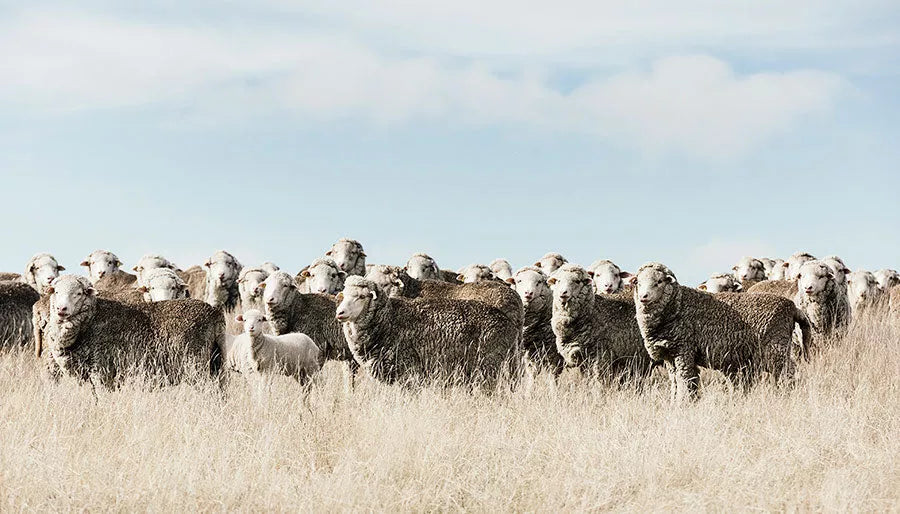
Wool You Believe It? Laird's Natural Choice for Sustainability
Share
At Laird Hatters, we believe true luxury begins with responsibility. As an English-made, locally focused business, we are constantly evaluating how to source our materials in a way that respects both people and planet. Sustainability is not a trend for us, but a principle — woven into everything we make.
One of the fibres we return to time and time again is wool. Resilient, breathable, renewable and biodegradable, wool is one of the most sustainable natural fibres available. This article is a closer look at why wool sits at the heart of our commitment to responsible craftsmanship, and why it continues to outperform synthetic alternatives on nearly every level.
Wool: The Original Eco Fibre
Wool has been used in clothing and textiles for thousands of years, and for good reason. It is 100% natural, renewable, and biodegradable — unlike synthetic fibres that rely on fossil fuels and never truly break down.
Each year, sheep grow a new fleece, making wool an endlessly renewable resource. When discarded, it breaks down naturally in soil and water, releasing valuable nutrients rather than polluting the environment.
Lower Energy, Less Water, Smaller Footprint
Wool’s environmental impact is significantly lower than many commonly used fibres. To produce 100 hats or caps:
-
Wool requires 18% less energy
-
Wool requires 70% less water than polyester
These savings contribute to a more sustainable production process overall, particularly when combined with local sourcing and small-scale manufacturing, as practised at Laird.
No Microplastics, No Worries
Unlike synthetic fabrics, wool does not shed harmful microplastics when washed or worn. Every time a synthetic garment is laundered, it releases tiny plastic particles that make their way into our rivers, oceans, and food systems. Wool naturally avoids this issue.
Because it is a protein-based fibre, wool decomposes in soil and marine environments within a few months, contributing to the ecosystem rather than polluting it.
Part of the Natural Carbon Cycle
Wool is one of the few fibres made from renewable atmospheric carbon. Through grazing and the growth of new fleece, sheep help convert atmospheric carbon into a renewable resource.
Even at the end of its life, discarded wool acts like a slow-release fertiliser, returning nutrients and carbon to the soil — enriching the land and supporting biodiversity.

Wool and the Carbon Cycle
In contrast to major synthetic fibres like polyester and acrylic — which are derived from fossil fuels and release ancient, stored carbon into the atmosphere — wool is made from renewable atmospheric carbon. This makes a fundamental difference in its environmental impact.
Synthetic fibres contribute to emissions by reintroducing carbon that has been locked away underground for millions of years. Wool, however, is part of a natural and ongoing carbon cycle. As sheep graze and grow new fleece, they help convert atmospheric carbon into a renewable, biodegradable resource.
Even at the earliest stages of wool production, regenerative farming practices can help sequester carbon in the soil. By enhancing grazing techniques, preserving grassland biodiversity, and enriching soil health, wool growers can actively remove carbon from the atmosphere and store it in the land.
Wool and Greenhouse Gas Management
The wool industry, particularly in countries like Australia — which produces over 90% of the world's fine apparel wool — is working actively to reduce greenhouse gas emissions.
Ongoing research is exploring ways to lower methane output and improve sustainability across the supply chain. Techniques include:
- Altering pasture species to improve digestion and reduce methane production in sheep
- Increasing soil carbon storage through improved land management
- Planting trees and shelterbelts to boost biodiversity and absorb carbon at the farm level
These practices are helping to build a more climate-resilient future for wool production, one rooted in stewardship and scientific innovation.

Why We Choose Wool at Laird
In a world increasingly dominated by cotton and synthetic fibres, wool stands apart. It is stronger, more repairable, more breathable, and more beautiful. It allows us to make hats and caps that are not only elegant and comfortable, but also crafted with environmental integrity.
Whether we’re using Yorkshire-milled tweed, British lambswool, or luxurious blends, every wool piece we create reflects our belief in local sourcing, high quality, and timeless design. Our goal is to offer products that last not just in terms of durability, but in the values they represent.
